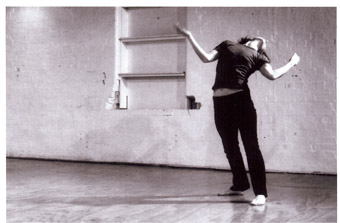nalina wait: five minutes of madness
pauline manley

Nalina Wait
photo Andrew Whoolley
Nalina Wait
Nalina Wait sits firmly upright: a sharply and simply perpendicular body. This position calls on and displays the power of a working dancer’s abdominal musculature and structural alignment. This centralised strength will be her engine room, her ballast and her home throughout this furious work that dances the nightmare.
This untitled, five minute dance piece uses light as a harbinger of madness. A darkened and peaceful pre-set dissipates as a solitary light, a humorously tilted standard lamp, generates the electricity of movement. The dancer is sleepily complicit as she turns on the light and becomes the heroine in a David Lynch-ian descent.
Wait’s head tilts slowly to the side, revealing the neck in a luscious moment that will be too quickly lost. This tilt takes her away from symmetry and begins the journey from surety to distraction. Rotation takes her torso to the ground, but, unable to rest, her arm involuntarily reaches away and pulls her up, up, up to her feet. Like her pelvis, Wait’s feet are knowing and solid, bound to the earth in gravitational suction, lifted in the arch and ever-ready for movement in a buoyancy only efficient strength can provide. These glorious feet will hold my attention as they spread and contract on a floor the dancer trusts. Her feet know when to speak and when to stay silent.
A blast of light floods the room with manic brilliance and instant heat: in a moment peace and logic are lost. The dancer charges at the audience only to suddenly halt. Movement will now become a frenetically flinging and flailing motif repeatedly modified, allowed and controlled by Wait’s deep sense of centre. Punctuating the wild hurling of limbs are moments of soft but measured collapse to floor and standing stillnesses where Wait stares out to an imagined place over our heads. Her eyes glaze meditatively, the dreamer arrested by the need for respite, however slight.
But repose is smashed apart by quick turns on feet sucked together to provide a solid base for her tilted spins. Wait doesn’t rise up in the ballerina’s releve: she hovers across and around the landscape, simultaneously light and gravitational, madly efficient. Little jumps twitch her up and back and around. Lunges pulse back and forth. Arms are held up and out to dry, dislocated from a dropping torso or stretched back, disappearing from her own arc of vision, unnaturally investigating the dark terrain behind. Grounded legs support madly carving lines of action creating a field of forces, exhausting and compelling to watch.
Wait is a dancer who understands the gradations, possibilities and fleshy realities of intensity and how to play with them. The variant forces of frenzy and stillness pull her around the stage and stop her in her tracks. Herein lies the dramatic tension that Wait speaks of in a post-performance discussion as a vital choreographic stimulant and structure. There are the conflicts of “arriving and never arriving”, the confluence of “surprise” and repetition, the solidity of structure and the spice of improvisation, the push of agency and the pull of unleashed psychology.
She is both affecting and affected as she dances and is danced by the torrential guitar that tears through air and bodies. A score that began as a metronomic chirp has become the slamming chords of violent nightmare, a dream that would sit any sweat soaked sleeper bolt upright. This is music a dancer must stand up to, it is huge and demanding, with screeching irregularities, that, like the dancing, writhe and rest. And Nalina Wait does stand up: apparent in the heaving breath that is testament to her effort and a lingering trace of psychic turmoil.
At last there is return to the possibility of gentle sleep, to the symmetry of perpendicularity, to a more lasting stillness and to sweet darkness.






